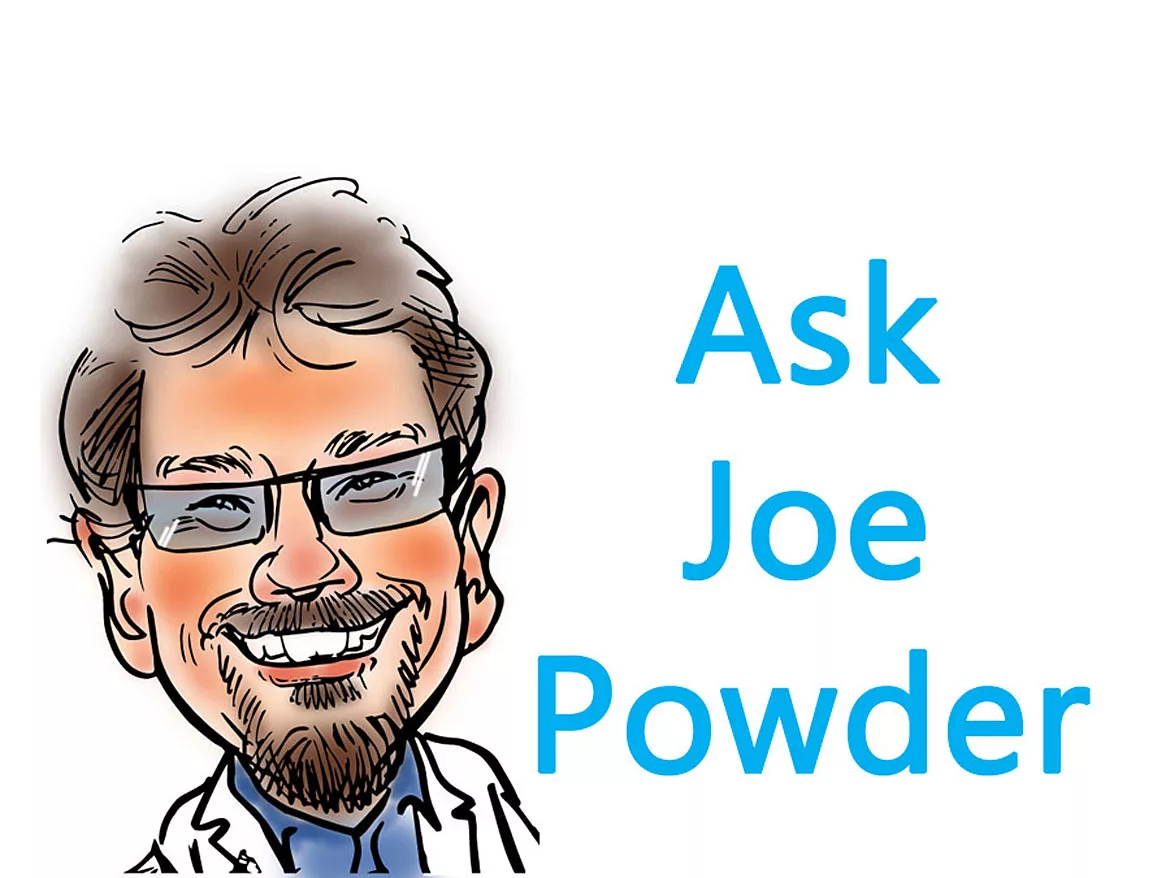Ask Joe Powder: Recoating Wrinkle Finishes

Our popular Ask Joe Powder blog has made its way to the pages of PCI magazine. What are your powder coating questions and challenges? Joe Powder, aka Kevin Biller of ChemQuest Powder Coating Research, shares his powder coating knowledge and expertise by answering questions sent in from around the world.
Dear Joe,
We currently use a "midnight black” wrinkle powder coating supplied by a major powder producer. Can a second touchup coat be applied after the first coat has cured? The first coat is being applied over cleaned HRPO (hot-rolled, pickled, and oiled) steel. The second touchup coat does not adhere to the first coat and flakes off easily. Any comments or suggestions?
Regards,
Loyd Fields
Austin, Texas
Dear Loyd,
Recoating wrinkle finishes can be a headache. This product is epoxy based, which makes the task even more difficult as epoxies cure “hard” and are less receptive to recoating. Your best option is to scuff sand the entire surface to be recoated, blow it off, then solvent wipe with acetone or MEK. This may provide the adhesion you need.
Using a polyester-based wrinkle is another option. These are not as hard as the epoxy wrinkle, which should make recoating somewhat easier. However, the polyester wrinkles are more sensitive to substrate surface defects and pretreatment streaking. HRPO steel can sometimes exhibit imperfections that may interfere with the development of a polyester wrinkle finish.
Therefore I would first try the scuff sanding followed by solvent wiping. If this doesn't work, you may be relegated to stripping the defective parts, cleaning them, and powder coating a virgin surface.
Good luck with sorting this out. Let me know how things progress.
Best Regards,
Joe
Dear Joe,
I have recently discovered your articles, and I have decided to contact you hoping that you can help me with my powder coating issues. First of all, we are considering bringing powder coating in house, which means creating a new powder coating line, so most of my questions are related to that:
1. Regarding the pretreatment process, personally, I would choose phosphating, and I am considering the five-stage process. However, I would like to avoid iron phosphate. We are coating electric bike frames, and since we must provide good corrosion protection, we use a zinc primer. Researching this topic led me also to the concept of applying the phosphate through spraying. In your opinion, what would be the best pretreatment option? I would be grateful if you could introduce me to any kind of literature in this area so I could investigate this topic further.
2. We are facing strict requirements when it comes to the quality of our products. The powder-coated surface should have no defects (or at least as little as possible). Currently we are facing the issue of small dotted inclusions, tiny hairs, and holes (whose origin we are still trying to investigate). We are solving this problem through polishing, but that requires a large amount of time, so I hope to avoid this step. Is it possible that the charged metal surface attracts those things? If it is, is there any way to avoid that? Could it be that the powder-coated area is not clean enough? I would be grateful if you could help me find the root cause of these problems.
3. We have also noticed that the clear coat we apply is quite susceptible to damage (after cleaning with a piece of cloth, scratches remain on the surface). Is the problem within the powder itself? What kind of powder clear coat could be used in this case?
4. One of the issues we encountered is the lack of gloss after the parts have been packaged. The gloss is ok after curing, but it seems like there is a sort of reaction between the paper we use for the packaging and the coating. Is that possible?
Hope to hear from you soon, and thank you in advance.
Best regards,
Senka Celik
Bosnia
Hi Senka,
Thank you for your message. Your questions are really good. I will try my best to answer them.
Regarding pretreatment, iron phosphate is probably the best option, as it is very common and easy to control. If you want to avoid phosphate because of effluents and issues with environmental impact, then you have other options. Zirconium-based pretreatments have been around for a while and are a good option. They require more precise control of the chemicals and processes; however, they have a significantly better environmental impact profile. There are chemical companies in Bosnia that can help you. I will private message you with their contact details.
As for application of the pretreatment, it depends on the volume of parts you plan to coat. If you can manage manual spray, it is a good low-cost option. If you have a high volume of parts and a fast-moving, conveyorized line, you will need to install an automated pretreatment process (very expensive and capital intensive). Please let me know how many parts you need to coat per hour or per working shift.
Regarding cleanliness of the powder coating finish; this is a very important, but difficult issue to manage. It is essential to have a clean environment to apply the powder. This entails an environmentally controlled enclosure around your application system (or your coater's). The incoming air should be filtered and there should be a net-positive pressure in the application area to prevent excess air entering from the outside environment into the spray room. It is tricky to achieve this balance and requires clever air movement management.
You need to identify the root cause of the defects you are observing in the finish. Is the coating clean to begin with? You need a high-quality powder supplier who can prove they make clean powder every time. You also need to be able to spray incoming powder off-line in a lab area with a small, clean lab oven. This allows you to determine if the contaminants come from your environment or from the powder itself. If you think it is your environment, spray a small part or lab test panel and place it into tin can and cure it in the oven. If it is clean, then the environment may be causing the defects.
You need to ensure that the metal cleaning process is clean, and contaminants are not present on the surface of the parts before they are powder coated.
Your comment about electrostatics influencing the deposit of contaminants is accurate. The electrostatic field will attract airborne contaminants to the surface of your parts. This is why the application area must be clean as possible.
The clear coat may be too soft and not abrasion-resistant enough to avoid scratching during handling. On the other hand, the handling process may be too aggressive for the clear coat. People should wear cotton gloves, and packaging materials should be soft, avoid rough kraft paper and cardboard. Polyurethane powders are much more scratch resistant than polyesters, however they are more expensive.
Packing materials can reduce gloss as they can leach plasticizers (if they're plastic or foam, of course). The same can occur with tapes and adhesives. Paper may be abrading the surface, and you would be able to quickly ascertain this if it is only on the surfaces that are in contact with the paper. Gloss reduction can also occur with some powders due to "blooming," which is inherent to some lower-cost powders. In addition, under-cured powders commonly "bloom" or exude low-molecular-weight materials to the surface, causing a hazy loss of gloss.
I hope this helps. Please let me know if you have any further questions.
Best regards,
Joe Powder
Looking for a reprint of this article?
From high-res PDFs to custom plaques, order your copy today!






